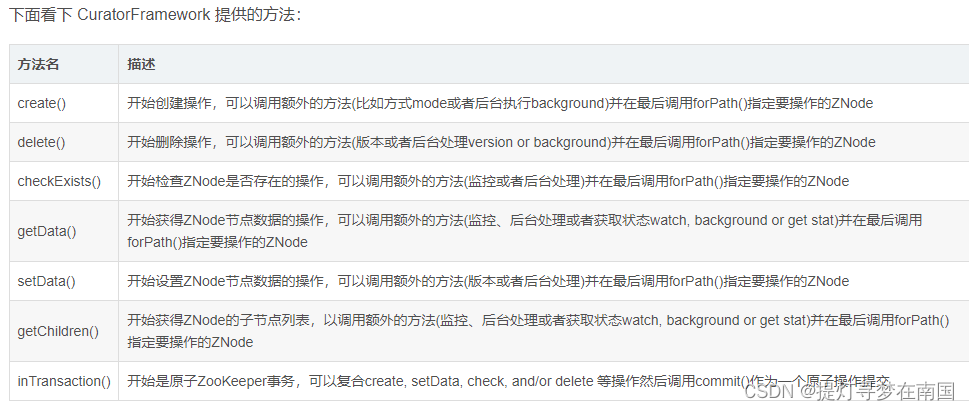前言
这篇文章主要基于客户端在日常工作中使用zk的角度来写,前面南国已经就zk的理论知识做过一些讲述,对此不太熟悉的可以往前看看。Curator是Apache提供的一个zk的工具包,简化了 ZooKeeper 的操作。它增加了很多使用 ZooKeeper 开发的特性,可以处理 ZooKeeper 集群复杂的连接管理和重试机制。这里我们使用springboot 集成curator来操作zk。
假设你的服务已经正确添加了zk的相关依赖,Curator maveny依赖如下,
<!-- curator-framework -->
<dependency>
<groupId>org.apache.curator</groupId>
<artifactId>curator-framework</artifactId>
<version>4.2.0</version>
<exclusions>
<exclusion>
<groupId>org.apache.zookeeper</groupId>
<artifactId>zookeeper</artifactId>
</exclusion>
</exclusions>
</dependency>
<!-- curator-recipes -->
<dependency>
<groupId>org.apache.curator</groupId>
<artifactId>curator-recipes</artifactId>
<version>4.2.0</version>
<exclusions>
<exclusion>
<groupId>org.apache.curator</groupId>
<artifactId>curator-framework</artifactId>
</exclusion>
</exclusions>
</dependency>
正文
Curator 功能分两大类,一类是对 ZooKeeper 的一些基本命令的封装,比如增删改查,即 Framework 模块;另一类是他的高级特性,即 Recipes 模块。
创建CuratorFramework
Curator 框架通过 CuratorFrameworkFactory 可以通过工厂模式或者builder 模式创建 CuratorFramework 实例。CuratorFramework 实例都是线程安全的,你应该在你的应用中共享同一个 CuratorFramework 实例。
在springboot中相当于创建一个curator的配置类
@Slf4j
@Configuration
public class ZkCoreClient {
// zk 服务端集群地址
@Value("${zk.url}")
private String zkUrl;
// session 超时时间
private int timeOut = 60000;
// zkclient 重试间隔时间
private int baseSleepTimeMs = 5000;
//zkclient 重试次数
private int retryCount = 5;
/**
* 使用double-check 创建client
*
* @return
*/
@Bean
public CuratorFramework init() {
CuratorFramework client = CuratorFrameworkFactory
.builder()
.connectString(zkUrl)
.sessionTimeoutMs(timeOut)
.retryPolicy(new ExponentialBackoffRetry(baseSleepTimeMs, retryCount))
// .namespace(appName)
.build();
// 或者使用工厂模式
// client = CuratorFrameworkFactory.newClient(zkUrl,new ExponentialBackoffRetry(baseSleepTimeMs,retryCount)).usingNamespace(appName);
client.start();
log.info("client is created at ================== {}", LocalDateTime.now());
return client;
}
}
查看curator的基本用法

/**
* @author: xiejiahao
* Date: 2022/3/14 17:13
* Description: zk 工具类
* 使用Curator 实现zk 的基本操作-增删查改数据 和监听watch
*/
@Slf4j
public class ZkUtils {
@Autowired
CuratorFramework client;
/**
* @param path
* @param value
* @Description: 创建路径
* @Date: 2020-08-22 15:15
*/
public String createNode(String path, String value) throws Exception {
return createNode(path, value, true);
}
public String createNode(String path, String value, Boolean isEphemeral) throws Exception {
if (null == client) {
throw new RuntimeException("there is not connect to zkServer...");
}
String node = client
.create()
.creatingParentsIfNeeded()
.withMode(isEphemeral.equals(true) ? CreateMode.EPHEMERAL_SEQUENTIAL : CreateMode.PERSISTENT_SEQUENTIAL) // 临时顺序节点/持久顺序节点
.forPath(path, value.getBytes());
log.info("create node : {}", node);
return node;
}
/**
* @param path
* @Description: 删除节点信息
* @Date: 2020-08-22 16:01
*/
public void deleteNode(String path) throws Exception {
if (null == client) {
throw new RuntimeException("there is not connect to zkServer...");
}
client.delete()
.guaranteed() // 保障机制,若未删除成功,只要会话有效会在后台一直尝试删除
.deletingChildrenIfNeeded() // 若当前节点包含子节点,子节点也删除
.forPath(path);
log.info("{} is deleted ", path);
}
/**
* 判断znode是否存在,Stat就是对znode所有属性的一个映射,stat=null表示节点不存在
*
* @param path
* @return
*/
public Stat isExists(String path) throws Exception {
if (null == client) {
throw new RuntimeException("there is not connect to zkServer...");
}
return client.checkExists().forPath(path);
}
/**
* 查询子节点
*
* @param path
* @return
* @throws Exception
*/
public List<String> getChildren(String path) throws Exception {
if (null == client) {
throw new RuntimeException("there is not connect to zkServer...");
}
return client.getChildren()
.forPath(path);
}
/**
* @param path
* @Description: 获取节点存储的值
* @Date: 2020-08-22 16:11
*/
public String getNodeData(String path) throws Exception {
if (null == client) {
throw new RuntimeException("there is not connect to zkServer...");
}
Stat stat = new Stat();
byte[] bytes = client.getData().storingStatIn(stat).forPath(path);
log.info("{} data is : {}", path, new String(bytes));
log.info("current stat version is {}, createTime is {}", stat.getVersion(), stat.getCtime());
return new String(bytes);
}
/**
* @param path
* @param value
* @Description: 设置节点 数据
* @Date: 2020-08-22 16:17
*/
public void setNodeData(String path, String value) throws Exception {
if (null == client) {
throw new RuntimeException("there is not connect to zkServer...");
}
Stat stat = client.checkExists().forPath(path);
if (null == stat) {
log.info(String.format("{} Znode is not exists", path));
throw new RuntimeException(String.format("{} Znode is not exists", path));
}
String nodeData = getNodeData(path);
client.setData().withVersion(stat.getVersion()).forPath(path, value.getBytes());
log.info("{} Znode data is set. old vaule is {}, new data is {}", path, nodeData, value);
}
/**
* @param path
* @Description: 创建 给定节点的监听事件 监听一个节点的更新和创建事件(不包括删除)
* @Date: 2020-08-22 16:47
*/
public void addWatcherWithNodeCache(String path) throws Exception {
if (null == client) {
throw new RuntimeException("there is not connect to zkServer...");
}
// dataIsCompressed if true, data in the path is compressed
NodeCache nodeCache = new NodeCache(client, path, false);
NodeCacheListener listener = () -> {
ChildData currentData = nodeCache.getCurrentData();
log.info("{} Znode data is chagnge,new data is --- {}", currentData.getPath(), new String(currentData.getData()));
};
nodeCache.getListenable().addListener(listener);
nodeCache.start();
}
/**
* @param path 给定节点
* @Description: 监听给定节点下的子节点的创建、删除、更新
* @Date: 2020-08-22 17:14
*/
public void addWatcherWithChildCache(String path) throws Exception {
if (null == client) {
throw new RuntimeException("there is not connect to zkServer...");
}
//cacheData if true, node contents are cached in addition to the stat
PathChildrenCache pathChildrenCache = new PathChildrenCache(client, path, false);
PathChildrenCacheListener listener = (client, event) -> {
log.info("event path is --{} ,event type is {}", event.getData().getPath(), event.getType());
};
pathChildrenCache.getListenable().addListener(listener);
// StartMode : NORMAL BUILD_INITIAL_CACHE POST_INITIALIZED_EVENT
// NORMAL:异步初始化, BUILD_INITIAL_CACHE:同步初始化, POST_INITIALIZED_EVENT:异步初始化,初始化之后会触发事件
pathChildrenCache.start(PathChildrenCache.StartMode.NORMAL);
}
/**
* @param path
* @Description: 监听 给定节点的创建、更新(不包括删除) 以及 该节点下的子节点的创建、删除、更新动作。
* @Date: 2020-08-22 17:35
*/
public void addWatcherWithTreeCache(String path) throws Exception {
if (null == client) {
throw new RuntimeException("there is not connect to zkServer...");
}
TreeCache treeCache = new TreeCache(client, path);
TreeCacheListener listener = (client, event) -> {
log.info("节点路径 --{} ,节点事件类型: {} , 节点值为: {}", Objects.nonNull(event.getData()) ? event.getData().getPath() : "无数据", event.getType());
};
treeCache.getListenable().addListener(listener);
treeCache.start();
}
}
Curator Recipes的使用
Recipes 模块主要有 Elections (选举)、Locks (锁)、Barriers (关卡)、Atomic (原子量)、Caches、Queues 等
Electtions 选举
选举主要依赖于 LeaderSelector 和 LeaderLatch 两个类。前者是所有存活的客户端不间断的轮流做 Leader。后者是一旦选举出 Leader,除非有客户端挂掉重新触发选举,否则不会交出领导权。这两者在实现上是可以切换的。
Locks(分布式锁)
curator 提供了InterProcessMutex来实现zk的分布式锁,他用acquire获取锁 release释放锁。
ZooKeeper分布式锁:
优点
ZooKeeper分布式锁(如InterProcessMutex),能有效地解决分布式问题,不可重入问题,使用起来也较为简单
缺点
ZooKeeper实现的分布式锁,性能并不太高。
因为每次在创建锁和释放锁的过程中,都要动态创建、销毁暂时节点来实现锁功能,
Zk中创建和删除节点只能通过Leader(主)服务器来执行,然后Leader服务器还需要将数据同步到所有的Follower(从)服务器上,这样频繁的网络通信,系统性能会下降。
总之,在高性能、高并发的应用场景下,不建议使用ZooKeeper的分布式锁,如果在并发量不是太高的应用场景中,还是推荐使用ZooKeeper的分布式锁。
目前分布式锁,比较成熟、主流的方案有两种:
基于Redis的分布式锁。适用于并发量很大、性能要求很高而可靠性问题可以通过其他方案去弥补的场景。
基于ZooKeeper的分布式锁。适用于高可靠,而并发量不是太高的场景
在选型时,选择适合于自己业务场景的方案即可。
简单的demo如下
@Autowired
CuratorFramework client;
/**
* 首先需要调用create 创建路径
* 尝试获取锁 包含解锁操作
* @param lockCallback
* @param lockKey
* @param timeout
* @param <T>
* @return
*/
public <T> TwoTuple<Boolean, T> tryLock(LockCallback<T> lockCallback, String lockKey, Long timeout) {
InterProcessMutex lock = new InterProcessMutex(client, lockKey);
try {
if (lock.acquire(timeout, TimeUnit.MILLISECONDS)) {
log.info(Thread.currentThread().getName() + " get lock");
return new TwoTuple<>(true, lockCallback.exec());
}
} catch (Exception e) {
e.printStackTrace();
} finally {
try {
log.info(Thread.currentThread().getName() + " release lock");
lock.release();
} catch (Exception e) {
e.printStackTrace();
}
}
return new TwoTuple<>(false, null);
}
服务注册发现
maven 添加依赖
<!-- curator 做服务发现-->
<dependency>
<groupId>org.apache.curator</groupId>
<artifactId>curator-x-discovery</artifactId>
<version>4.2.0</version>
</dependency>
/**
* 服务注册:将当前启动的服务信息(采用map的形式)进行注册到zk中。
* 这里采用的是map 可以自定义类
*/
public void registerService(String serviceName, String... urls) throws Exception {
ServiceInstanceBuilder<Map> serviceInstanceBuilder = ServiceInstance.builder();
serviceInstanceBuilder.address(InetAddress.getLocalHost().getHostAddress());
serviceInstanceBuilder.port(Integer.parseInt(environment.getProperty("server.port")));
serviceInstanceBuilder.name(serviceName);
Map config = new HashMap();
config.put("url", urls);
serviceInstanceBuilder.payload(config);
ServiceInstance<Map> serviceInstance = serviceInstanceBuilder.build();
ServiceDiscovery<Map> serviceDiscovery = ServiceDiscoveryBuilder.builder(Map.class)
.client(client).serializer(new JsonInstanceSerializer<Map>(Map.class))
.basePath(SERVICE_ROOT_PATH).build();
serviceDiscovery.registerService(serviceInstance);
serviceDiscovery.start();
}
/**
* 服务发现:通过serviceDiscovery查询到服务
*/
public void discovery(String serviceName) {
try {
ServiceDiscovery<Map> serviceDiscovery = ServiceDiscoveryBuilder.builder(Map.class)
.client(client).basePath(SERVICE_ROOT_PATH).build();
serviceDiscovery.start();
//根据名称获取服务
Collection<ServiceInstance<Map>> services = serviceDiscovery.queryForInstances(serviceName);
for (ServiceInstance<Map> service : services) {
System.out.print(service.getPayload() + " -- ");
System.out.println(service.getAddress() + ":" + service.getPort());
}
System.out.println();
} catch (Exception e) {
e.printStackTrace();
}
}
参考资料:
https://blog.csdn.net/smartbetter/article/details/53083816
https://www.icode9.com/content-1-116250.html